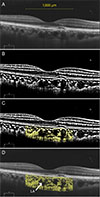Abstract
Purpose
Methods
Results
Figures and Tables
 | Fig. 1Enhanced depth imaging optical coherence tomography and processing for converting binary to obtain the choroidal vascularity index. (A) Subfoveal choroidal area within a width of 1,500 µm was selected using the polygon selection tool and the total choroidal area was marked. (B) To get a clear cut of the choroid-scleral junction, the Niblack autolocal threshold tool was used. (C) Then, the selected region was added to the region of interest manager. (D) By using the color threshold, luminal area (LA, arrow) was described and subsequently added to the region of interest manager. LA appeared as an area of dark pixels and stromal area as an area of light pixels. Total choroidal area, LA, and stromal area were calculated. Choroidal vascularity index was calculated by dividing the LA by the total circumscribed subfoveal choroidal area. |
 | Fig. 2Changes in (A) best-corrected visual acuity (BCVA), (B) subretinal fluid (SRF) height, (C) subfoveal choroidal thickness (SFCT), and (D) choroidal vascularity index (CVI) during the 3-month follow-up period. *p < 0.05, calculated by comparing initial data and follow-up data; †p < 0.05, calculated by comparing the difference between the two groups at each follow-up visit. |
 | Fig. 3Comparison of changes in subretinal fluid (SRF) height, subfoveal choroidal thicknes (SFCT), and choroidal vascularity index (CVI) during the three-month follow-up period in (A) group 1 and (B) group 2. *p < 0.05, calculated by comparing baseline and follow-up data. |
 | Fig. 4Comparison of choroidal thickness changes including the main central serous chorioretinopathy (CSC) lesion and the subfoveal choroidal thickness during the 3-month follow-up period in each group. *p < 0.05, calculated by comparing baseline and follow-up data. |
Table 1
Demographic and clinical characteristics organized by study group

Data are expressed as mean ± standard deviation unless otherwise indicated.
BCVA = best-corrected visual acuity; logMAR = logarithm of the minimum angle of resolution; SRF = subretinal fluid; SFCT = subfoveal choroidal thickness; CVI = choroidal vascularity index.
*Calculated using the chi-squared test for categorical variables and the Mann-Whitney U-test for continuous variables.
Table 2
Clinical and anatomical data and differences during follow-up

Data are expressed as mean ± standard deviation.
BCVA = best-corrected visual acuity; logMAR = logarithm of the minimum angle of resolution; SRF = subretinal fluid; SFCT = subfoveal choroidal thickness; CVI = choroidal vascularity index.
*Calculated by comparing baseline and follow-up data; †Calculated by comparing the difference between two groups; ‡p < 0.05.




 PDF
PDF ePub
ePub Citation
Citation Print
Print


 XML Download
XML Download